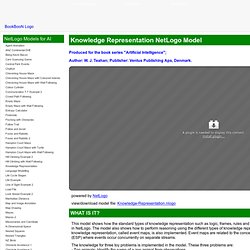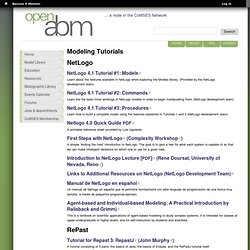

Newest 'netlogo' Questions. Artificial Intelligence - Volume 1: Knowledge-Representation NetLogo Model. Produced for the book series "Artificial Intelligence"; Author: W.

J. Teahan; Publisher: Ventus Publishing Aps, Denmark. powered by NetLogo view/download model file: Knowledge-Representation.nlogo This model shows how the standard types of knowledge representation such as logic, frames, rules and decision trees can be implemented in NetLogo. The knowledge for three toy problems is implemented in the model. The purpose of this model is to show how to represent knowledge using the traditional forms of knowledge representation such as first order logic, frames, rules and decision trees. The different forms of knowledge are represented using state turtle agents and path link agents that are used to describe a transition path between the states. The states and paths form a finite state network.
First pick a type of knowledge representation using the KR-type chooser in the Interface. The model's Interface buttons are defined as follows: Lab_06. Having completed the first five learning labs, you should be getting much more comfortable using NetLogo. Lab 6 is designed to provide one last opportunity to both improve your confidence and build your skills.
This Lab uses our Seven-Step Modeling Process to walk through the process of creating an original model of how a fire spreads (with many changes from the Fire Model you modified in Lab 4). The lab is certainly not for total beginners, as it requires YOU to work through most of the details of putting the model together - unlike some of the earlier Labs. To start, read through the Study Guide on the Modeling Process. NetLogo Models for Artificial Intelligence. First Steps with NetLogo. First Steps with NetLogo Lets take a few first steps with our modeling frameworks. We will be fairly brief , limiting ourselves to simple "kicking the tires" and writing a hello world in each ABM system (here is the RePast First Steps). Our goal is to gain a feel for what each system is capable of so that we can make intelligent decisions on which one to use for a given task.
Note: most images below can be clicked on for a full size image. NetLogo. Netlogo. Netlogo. NetLogo. Netlogo. NetLogo. NetLogo. NetLogo. NetLogo. Lesson 10. Lesson 11. Lesson 12. Lesson 13. Lesson 14. Lesson 15. Lesson 16. Lesson 17. Open Agent Based Modeling Consortium. NetLogo 4.1 Tutorial #1: Models Learn about the features available in NetLogo while exploring the Models library.

(Provided by the NetLogo development team) NetLogo 4.1 Tutorial #2: Commands Learn the the basic inner workings of NetLogo models in order to begin manipulating them (NetLogo development team) NetLogo 4.1 Tutorial #3: Procedures Learn how to build a complete model using the features explained in Tutorials 1 and 2 (NetLogo development team) Netlogo 4.0 Quick Guide PDF A printable reference sheet provided by Luis Izquierdo. First Steps with NetLogo (Complexity Workshop) A simple “kicking the tires” introduction to NetLogo. Introduction to NetLogo Lecture [PDF] (Rene Doursat, University of Nevada, Reno) Links to Additional Resources on NetLogo (NetLogo Development Team) Manual de NetLogo en español Un manual de Netlogo en español que te permitirá familiarizarte con este lenguaje de programación de una forma muy sencilla, a través de pequeños programas-ejemplo. RePast/S. CoolWorld. This applet requires Java 1.4.1 or higher.

You may obtain the latest Java plugin from Sun's Java site. created with NetLogoview/download model file: CoolWorld.nlogo CoolWorld is an agent-based model designed to illustrate the usefulness of the theory of Markov chains to analyse computer models. This section explains the formal model that CoolWorld implements. The information provided here should suffice to re-implement the same formal model in any sophisticated enough modelling platform.
The environment The environment in CoolWorld is a 2-dimensional grid divided into square patches. Each individual patch has a specific temperature, which is a floating-point number in the interval [0, 100]. Unless the user interacts with the model at run-time, neither the temperature profile nor the distribution of houses changes during the course of a simulation run. The agents Agents in CoolWorld are called walkers, as walking on the environment is pretty much all they do. Scheduling of events Displays. 6.pdf (objeto application/pdf) NetLogo Home Page. NetLogo is a multi-agent programmable modeling environment.

It is used by tens of thousands of students, teachers and researchers worldwide. It also powers HubNet participatory simulations. It is authored by Uri Wilensky and developed at the CCL. You can download it free of charge. What can you do with NetLogo? Join mailing lists here. The Center for Connected Learning and Computer-Based Modeling. Evolutionary Computing/Social Complexity. Caos e fractais. Section 10: Markov Processes.